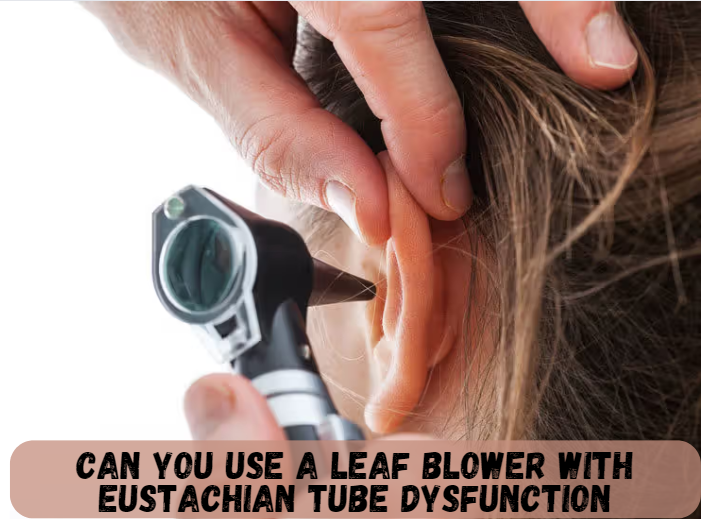Eustachian Tube Dysfunction (ETD) is a condition that affects the small passageway between the middle ear and the upper throat, leading to symptoms such as ear pain, pressure, muffled hearing, and a feeling of fullness in the ear. For those suffering from ETD, managing daily activities and exposure to certain environmental factors becomes crucial.
One such activity that raises concerns is the use of a leaf blower. This article delves deep into the question: Can you use a leaf blower with Eustachian Tube Dysfunction? We will explore the risks, provide insights into how leaf blowers can impact ETD, and offer guidance for those looking to manage their condition while maintaining their outdoor spaces.
Contents
- 1 Understanding Eustachian Tube Dysfunction (ETD)
- 2 Leaf Blowers and Eustachian Tube Dysfunction: A Risky Combination?
- 3 Practical Considerations: Should You Use a Leaf Blower with Eustachian Tube Dysfunction?
- 4 Medical Advice: Consult Your Doctor
- 5 Frequently Asked Questions (FAQs)
- 5.1 1. Can I use a leaf blower if I have mild Eustachian Tube Dysfunction?
- 5.2 2. What alternatives to leaf blowers are available for people with Eustachian Tube Dysfunction?
- 5.3 3. How can I protect my ears while using a leaf blower if I have Eustachian Tube Dysfunction?
- 5.4 4. Can Eustachian Tube Dysfunction be cured, or is it a lifelong condition?
- 5.5 5. Is it safe to use other loud outdoor equipment, such as lawnmowers, with Eustachian Tube Dysfunction?
- 6 Conclusion
Understanding Eustachian Tube Dysfunction (ETD)
What is Eustachian Tube Dysfunction?
The Eustachian tube is a small canal that connects the middle ear to the nasopharynx, which is the upper part of the throat that lies behind the nose. This tube helps to equalize the pressure on both sides of the eardrum, drain fluid from the middle ear, and protect the ear from nasopharyngeal secretions and loud sounds. Eustachian Tube Dysfunction occurs when this tube fails to open properly or becomes blocked, leading to a variety of uncomfortable and sometimes painful symptoms.
Symptoms of Eustachian Tube Dysfunction
- Ear Pain or Discomfort: A common symptom of ETD is pain in one or both ears, often caused by the unequal pressure on the eardrum.
- Feeling of Fullness in the Ear: Patients often describe a sensation of fullness or a “blocked” feeling in the ear.
- Muffled Hearing: Due to the blockage or improper functioning of the Eustachian tube, sounds may seem muffled or distant.
- Tinnitus: Ringing or buzzing in the ears can be another symptom, resulting from the dysfunction.
- Balance Problems: The Eustachian tube also plays a role in balance, and dysfunction can lead to dizziness or unsteadiness.
- Popping or Clicking Sensation: Some individuals may experience a popping or clicking noise in their ears, particularly when swallowing or yawning.
Causes of Eustachian Tube Dysfunction
Eustachian Tube Dysfunction can be caused by various factors, including:
- Allergies: Allergic reactions can lead to inflammation and swelling of the Eustachian tube, causing it to become blocked.
- Colds and Sinus Infections: Respiratory infections often lead to the accumulation of mucus, which can block the Eustachian tube.
- Changes in Air Pressure: Rapid changes in altitude, such as during air travel or driving through mountains, can cause the Eustachian tube to struggle with pressure equalization.
- Structural Issues: Some individuals may have a naturally narrower Eustachian tube, making them more prone to dysfunction.
Leaf Blowers and Eustachian Tube Dysfunction: A Risky Combination?
The Mechanics of a Leaf Blower
Leaf blowers are powerful tools designed to move debris, leaves, and other outdoor materials through the force of air. They generate a strong, focused stream of air, often at high speeds, which is effective for outdoor cleaning but can also produce significant noise and vibrations.
Impact of Air Pressure and Vibration
For individuals with Eustachian Tube Dysfunction, the high air pressure and vibration produced by a leaf blower can pose significant risks:
- Increased Ear Pressure: The intense airflow from a leaf blower can cause rapid changes in air pressure around the ears, which may exacerbate the symptoms of ETD, leading to increased pain, discomfort, and a greater sense of fullness in the ear.
- Vibrational Impact: The vibrations produced by holding and operating a leaf blower can travel through the body and affect the ears, potentially worsening symptoms such as tinnitus or muffled hearing.
- Aggravation of Symptoms: The combination of noise, pressure, and vibration can lead to a significant aggravation of ETD symptoms, making it a potentially hazardous activity for those with the condition.
Noise and Its Effects on Eustachian Tube Dysfunction
Leaf blowers are notoriously loud, often producing noise levels that exceed safe hearing thresholds. For someone with Eustachian Tube Dysfunction, exposure to such noise can be problematic:
- Noise-Induced Stress: Loud noises can cause stress and anxiety, which can, in turn, worsen ETD symptoms. The stress response can lead to further tightening and dysfunction of the Eustachian tube.
- Exacerbation of Tinnitus: If you already experience tinnitus as a symptom of ETD, the loud noise from a leaf blower can intensify the ringing or buzzing sounds in your ears.
Practical Considerations: Should You Use a Leaf Blower with Eustachian Tube Dysfunction?
Assessing the Risks
Given the potential risks associated with using a leaf blower when you have Eustachian Tube Dysfunction, it’s important to carefully assess whether the benefits outweigh the risks. Consider the following:
- Severity of Your Symptoms: If your ETD symptoms are mild and well-managed, you may be able to use a leaf blower with some precautions. However, if your symptoms are severe or easily triggered, it may be best to avoid using a leaf blower altogether.
- Duration of Exposure: The longer you are exposed to the noise, vibration, and air pressure changes caused by a leaf blower, the greater the risk of exacerbating your symptoms. Limiting your exposure time can help mitigate some risks.
- Use of Protective Gear: Using ear protection, such as noise-canceling earmuffs, can reduce the impact of loud noises on your ears. However, this does not eliminate the risk of pressure changes and vibrations affecting your ETD.
Alternatives to Using a Leaf Blower
If you decide that using a leaf blower is too risky for your condition, there are several alternatives you can consider:
- Rakes and Brooms: Traditional tools like rakes and brooms can be used to clear leaves and debris from your yard without the noise and pressure changes associated with leaf blowers.
- Electric Leaf Vacuums: Electric leaf vacuums tend to produce less noise and vibration compared to gas-powered leaf blowers. While they still generate some airflow, the risks may be lower, making them a potential alternative.
- Hiring a Landscaping Service: If maintaining your yard is challenging due to ETD, consider hiring a professional landscaping service to handle tasks that would otherwise require a leaf blower.
Tips for Safely Using a Leaf Blower with Eustachian Tube Dysfunction
If you choose to use a leaf blower despite having Eustachian Tube Dysfunction, follow these tips to minimize the potential risks:
- Use Hearing Protection: Invest in high-quality noise-canceling earmuffs or earplugs to reduce the impact of loud noises on your ears.
- Limit Exposure Time: Use the leaf blower for short periods and take frequent breaks to allow your ears to recover.
- Maintain a Safe Distance: Keep the leaf blower nozzle at a safe distance from your ears to minimize direct exposure to high-pressure air.
- Avoid Windy Days: Using a leaf blower on a windy day can exacerbate the pressure changes around your ears, increasing the risk of aggravating your symptoms.
Medical Advice: Consult Your Doctor
Importance of Consulting a Healthcare Professional
Before deciding whether to use a leaf blower if you have Eustachian Tube Dysfunction, it is crucial to consult with a healthcare professional, such as an ENT (Ear, Nose, and Throat) specialist. They can provide personalized advice based on the severity of your condition and recommend strategies to manage your symptoms effectively.
Potential Treatments for Eustachian Tube Dysfunction
While managing your exposure to potential triggers is important, addressing the underlying causes of Eustachian Tube Dysfunction can also help improve your quality of life. Treatments may include:
- Medications: Decongestants, antihistamines, or nasal steroids may be prescribed to reduce inflammation and help clear the Eustachian tube.
- Eustachian Tube Exercises: Specific exercises, such as swallowing, yawning, or the Valsalva maneuver, can help open the Eustachian tube and equalize pressure.
- Surgery: In severe cases, surgical interventions such as balloon dilation of the Eustachian tube may be considered.
Long-Term Management of Eustachian Tube Dysfunction
For individuals with chronic Eustachian Tube Dysfunction, developing a long-term management plan is essential. This may include avoiding known triggers, using protective gear, and seeking regular medical check-ups to monitor and manage the condition effectively.
Frequently Asked Questions (FAQs)
1. Can I use a leaf blower if I have mild Eustachian Tube Dysfunction?
It depends on the severity of your symptoms. If your ETD is mild and well-controlled, you may be able to use a leaf blower with precautions, such as wearing hearing protection and limiting exposure time. However, it’s essential to consult with your doctor before making a decision.
2. What alternatives to leaf blowers are available for people with Eustachian Tube Dysfunction?
Alternatives include using manual tools like rakes and brooms, opting for electric leaf vacuums, or hiring a landscaping service to manage your yard work without the risks associated with leaf blowers.
3. How can I protect my ears while using a leaf blower if I have Eustachian Tube Dysfunction?
To protect your ears, use noise-canceling earmuffs or earplugs, limit the time you spend using the leaf blower, and maintain a safe distance between the blower nozzle and your ears. Avoid using the leaf blower on windy days to reduce the risk of pressure changes.
4. Can Eustachian Tube Dysfunction be cured, or is it a lifelong condition?
The outlook for Eustachian Tube Dysfunction varies depending on the underlying cause. In some cases, it can be managed effectively with medications, exercises, and lifestyle changes. However, chronic ETD may require ongoing management and, in some cases, surgical intervention.
5. Is it safe to use other loud outdoor equipment, such as lawnmowers, with Eustachian Tube Dysfunction?
Similar to leaf blowers, other loud outdoor equipment like lawnmowers can also pose risks to individuals with Eustachian Tube Dysfunction. It’s essential to take similar precautions, such as using hearing protection and limiting exposure time. Always consult with your doctor before using any loud equipment if you have ETD.
Conclusion
The question, can you use a leaf blower with Eustachian Tube Dysfunction? requires careful consideration of the potential risks and the severity of your symptoms. While it may be possible for some individuals to use a leaf blower with the right precautions, others may find it too risky.
Consulting with a healthcare professional, exploring alternative methods for yard maintenance, and taking steps to protect your ears are all crucial strategies for managing Eustachian Tube Dysfunction effectively.
By prioritizing your ear health and making informed decisions, you can reduce the impact of ETD on your daily life and enjoy a safer, more comfortable experience while caring for your outdoor spaces.




